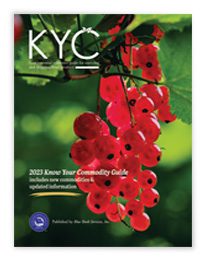Pepper (greenhouse) Market Summary


Image: Santirat Praeknokkaew/Shutterstock.com
Pepper (greenhouse) Market Overview
Bell peppers are among the many common household varieties of Capsicum annuum, an annual shrub belonging to the nightshade family. Colors of bell peppers might be green, orange, yellow, purple, brown, or red depending on maturity. Sugar content increases with ripeness, hence red peppers are considered the sweetest and green more bitter. Botanically speaking, the pepper is a fruit because it has seeds. As demand for fresh bell peppers climbs, supply has been increasingly augmented by greenhouse production. Though most peppers are imported from Canada and Mexico, as well as the Netherlands, Spain, Israel, and the Dominican Republic, U.S. production is rapidly expanding with new greenhouses popping up across the country. Even within a protected environment, pepper yields will vary by location, season, plant density, trellis system, cultivar, irrigation, and fertilizer management.
Types & Varieties of Peppers (greenhouse)
The most common greenhouse peppers are the sweet bell varieties—green, orange, yellow, and red. Cultivars are generally hybrids selected for marketability, pest and disease resistance or tolerance, and overall yield and quality. Among the popular varieties are Parker, Triple 4, Cubico, and Lorca for red; Kelvin for yellow; and Neibla and Emily for orange. New cultivars for greenhouse production are regularly introduced by seed companies. Cultivars can be distinctly different, enough to require varying growing environments for maximum yield. Some greenhouse growers are also experimenting with field-grown varieties.Cultivation of Peppers (greenhouse)
Peppers are generally grown in a soil-less culture. Nursery pots or flat polyethylene bags are used. Containers are filled with perlite, pine bark, peat mixes, or sawdust. At the time of transplanting, seedlings can be irrigated up to 10 times per day, with increased watering during higher light levels and longer days. Night irrigation may be considered during warmer weather. Ventilation provides a more uniform climate and helps distribute heat. Temperature is regulated, depending on the stage of development and cultivar grown. Generally, temperatures should not exceed 70 to 79°F, with an optimum temperature range of 70 to 73°F. Plants generally grow up to 6 feet tall during a season with vertical support. Peppers are often trellised with the “V” system or in a double-row trellis via the “Spanish” system. In the Spanish method, the plant is allowed to grow without pruning. When pruning is required, plants are generally managed with two main stems and pruned every two weeks. It is important to ensure the main stem or growing point remains intact.Pests & Diseases Affecting Peppers (greenhouse)
Pests are reduced but not eliminated in greenhouses. Transplants should be free of pests and weeds when brought into the structure. Major pests include aphids, gnats, mites, thrips, whiteflies, and pepper weevils. Yellow spot can occur from environmental stresses such as cooler temperatures or poor ventilation, but can be minimized by cultivars with less susceptibility to stress. Fruit cracking results when plants receive too much water or humidity is too high. Peppers with thick-walled fruit are more susceptible to cracking than thinner fruit. Flat or misshapen fruit is caused by low temperatures, usually over the course of several days. Blossom-end rot can be caused by reduced calcium absorption. Sunscald can occur under too much sunlight. Symptoms of sunscald appear similar to blossom-end rot, adequate leaf cover to shade the fruit from direct sunlight is recommended. Elephant’s foot is a physiological disorder from high humidity and/or salt accumulation around stem bases, causing tissue to become more susceptible to pathogens. Infected stems become flared and swollen forcing the outer tissues to peel back, revealing a soft, brown rot. Common fungal diseases are powdery mildew and fusarium stem rot. Powdery mildew causes reduced plant vigor and exposes fruit to sunscald. Symptoms include white to grey spots on the underside of mature leaves. Lesions appear yellow or as raised, pimply areas on upper leaf surfaces. Fusarium stem rot symptoms include dark brown or black lesions on stems, petioles, or fruit. Lesions typically develop at the base where two main stems divide. Airborne spores from grey mold can enter the greenhouse on insects, which then cause infections. References: Agriculture & Agri-Food Canada, Alberta Agriculture and Rural Development, Foodland Ontario, University of Florida, USDA, USDA National Agricultural Library.
Grades & Good Arrival of Peppers (greenhouse)
Peppers are graded according to USDA standards: U.S. Fancy (firm and well-shaped), U.S. No. 1 (firm and fairly well-shaped), and U.S. No. 2 (firm and not seriously misshapen).Generally speaking, the percentage of defects shown on a timely government inspection certificate should not exceed the percentage of allowable defects, provided: (1) transportation conditions were normal; (2) the USDA or CFIA inspection was timely; and (3) the entire lot was inspected.
| U.S. Grade Standards | Days Since Shipment | % of Defects Allowed | Optimum Transit Temp. (°F) |
| 10-5-2 | 5 4 3 2 1 | 15-8-4 14-8-4 13-7-3 12-6-2 10-5-2 | 45-55° |
Availability of Peppers (greenhouse)
| CANADA | MEXICO | UNITED STATES | OTHER INTERNATIONAL |
| Alberta British Columbia Ontario Quebec | Baja* Colima Hidalgo Jalisco Michoacán Querétaro San Luis Potosi Sinaloa Sonora Zacatecas | Arizona California Colorado Florida Illinois Michigan Ohio Texas | Dominican Republic Israel Netherlands Spain |

